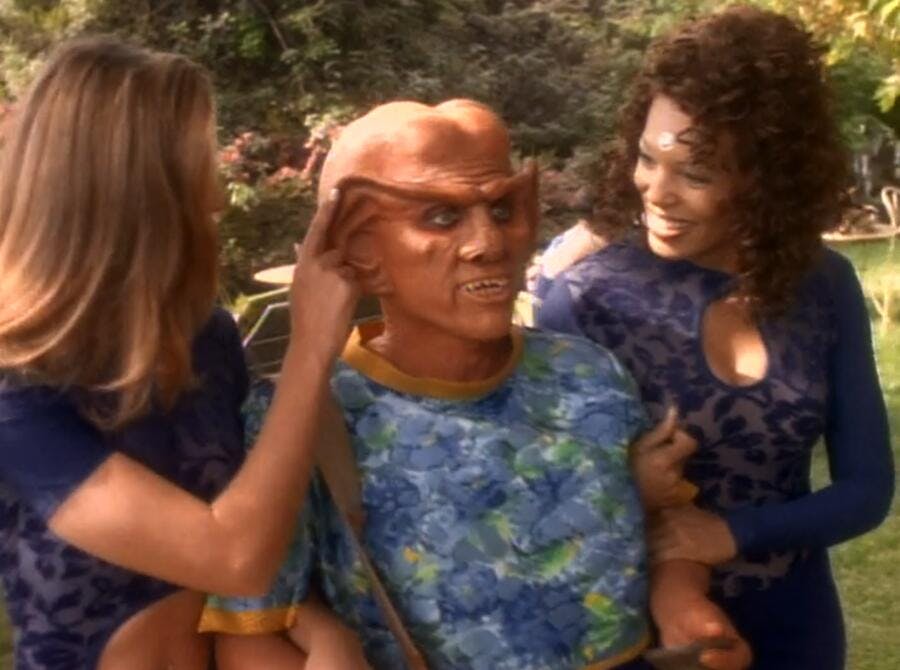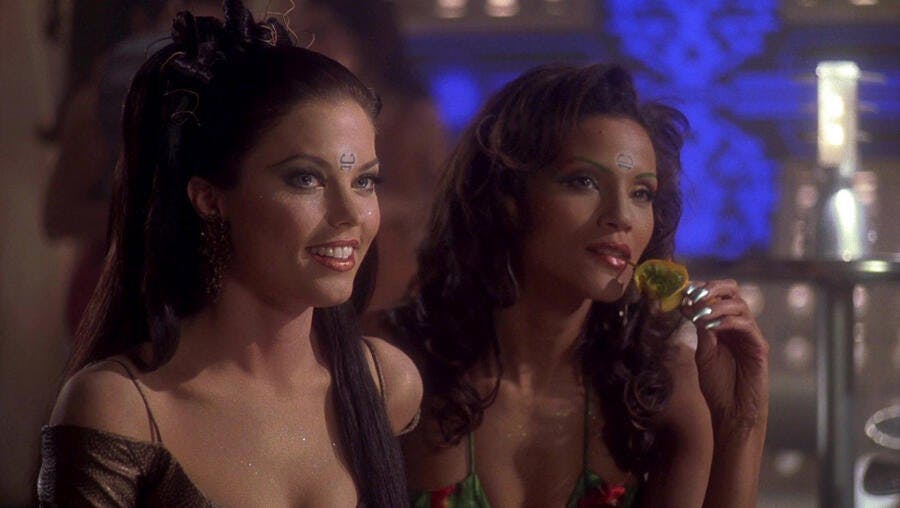Published Jun 29, 2023
The Planet Risa and Gene Roddenberry’s Unrealized Queer Vision
The pleasure planet was supposed to depict a future open to all sexualities. So what happened?

StarTrek.com
About 90 light years from the Sol System, in the vicinity of Starbase 12, you’ll find the pleasure planet, Risa. Beautifully green-and-blue and surrounded by two moons, it’s one of the most famous holiday destinations in the entire Federation, though perhaps, not a very family-friendly one.
The planet’s motto is “All that is ours is yours,” and the Risian people live up to it with a very open attitude towards sexuality and pleasure, doling both out liberally to any visiting tourist. As long as you hold a horga'hn (a Risian fertility symbol), the locals will know that you seek jamaharon, a sexual rite that is open to everybody, no matter what species or gender they are. We know that there's no trouble procuring a horga'hn or participating in the jamaharon from the Ferengi Quark in Star Trek: Deep Space Nine's “Let He Who Is Without Sin...” or from the male Risians carefully attending to female guests in Star Trek: The Next Generation's “Captain’s Holiday."

StarTrek.com
Yes, Risa truly is paradise... as long as you’re straight. For all we know, the planet might be LGBTQ-friendly, but — with one possible exception that we’ll get to later — we never get to see it. For the most part, though, Risa seems to have an almost “don’t ask, don’t tell” feel towards queerness of any sort, but it almost was the exact opposite.
Risa was the brainchild of Ira Steven Behr, who wrote “Captain’s Holiday.” According to William Shatner Presents: Chaos on the Bridge, a 2014 documentary, Gene Roddenberry approved Behr’s concept for a pleasure planet; but he wanted to make one change to it. He wanted some Risian locals to be openly gay/queer because, in the future that he envisioned, there was room not just for every race or species, but also sexuality. The Next Generation's executive producer Rick Berman, however, reportedly told Behr to ignore the note. As a result, for years, the most LGBTQ-adjacent thing that happened on Risa was when Commander Tucker and Malcolm Reed were flirting with two women, who later turned out to be male alien muggers in disguise (Star Trek: Enterprise's “Two Days and Two Nights”).

StarTrek.com
“Let He Who Is Without Sin…” did attempt to do something different. In the episode, Jadzia Dax and Worf visit Risa where they come across Arandis, a local woman who used to know the symbiont Dax when it inhabited a male Trill named Curzon. Arandis and Curzon were very well acquainted with each other. In fact, Curzon died on Risa while seeking jamaharon with Arandis, necessitating the transplantation of the symbiont to a new host — Jadzia. She now carries Curzon’s memories and experiences, some of which include an unspoken but undeniable attraction to Arandis, much to Worf’s chagrin. There is even a scene where the two women engage in a very flirty exercise of making pottery together because to the symbionts (who change genders depending on the host) and the uninhibited Risians, gender has very little to do with attraction. This, it seems, was closer to the Risa that Gene Roddenberry envisioned.
Another great thing that “Let He Who Is Without Sin…” did for Risa was adding to its history and turning it into a metaphor for all of Star Trek. Prior to the episode, Risa was essentially a planet of hats; it only had one defining characteristic, which was a beach resort sort of theme. It had sand, it had oceans and lagoons, it had shoreside villas, and it had people constantly walking around in bikinis and see-through plastic ensembles. The DS9 episode expanded heavily on that. As Worf explained it, Risa is an “artificially created paradise maintained by the most elaborate weather control system in the Federation. In its natural state, Risa is little more than a rain-soaked geologically unstable jungle,” constantly plagued by monsoons and devastating earthquakes.

StarTrek.com
In other words, Risa is only Risa thanks to technology, freeing the planet’s residents from danger, allowing them to live out their best lives and be their truest selves, in peace and quiet. That gets to the very core of Star Trek, which is ultimately a celebration of science and progress, and all the wonderful things they can do for us. That aspect is 100% on board with Gene Roddenberry’s vision for Star Trek, which he sadly never got to see.
Perhaps a good way of further honoring Roddenberry’s memory is revisiting Risa in the future and making it a little bit more LGBTQ-friendly. After all, Paul Stamets, Hugh Culber, and the Kelvin-verse’s Hikaru Sulu cannot be all the representation that the franchise gets. Risa sounds like a great place to continue what they started.
This article was originally published on August 13, 2019.





